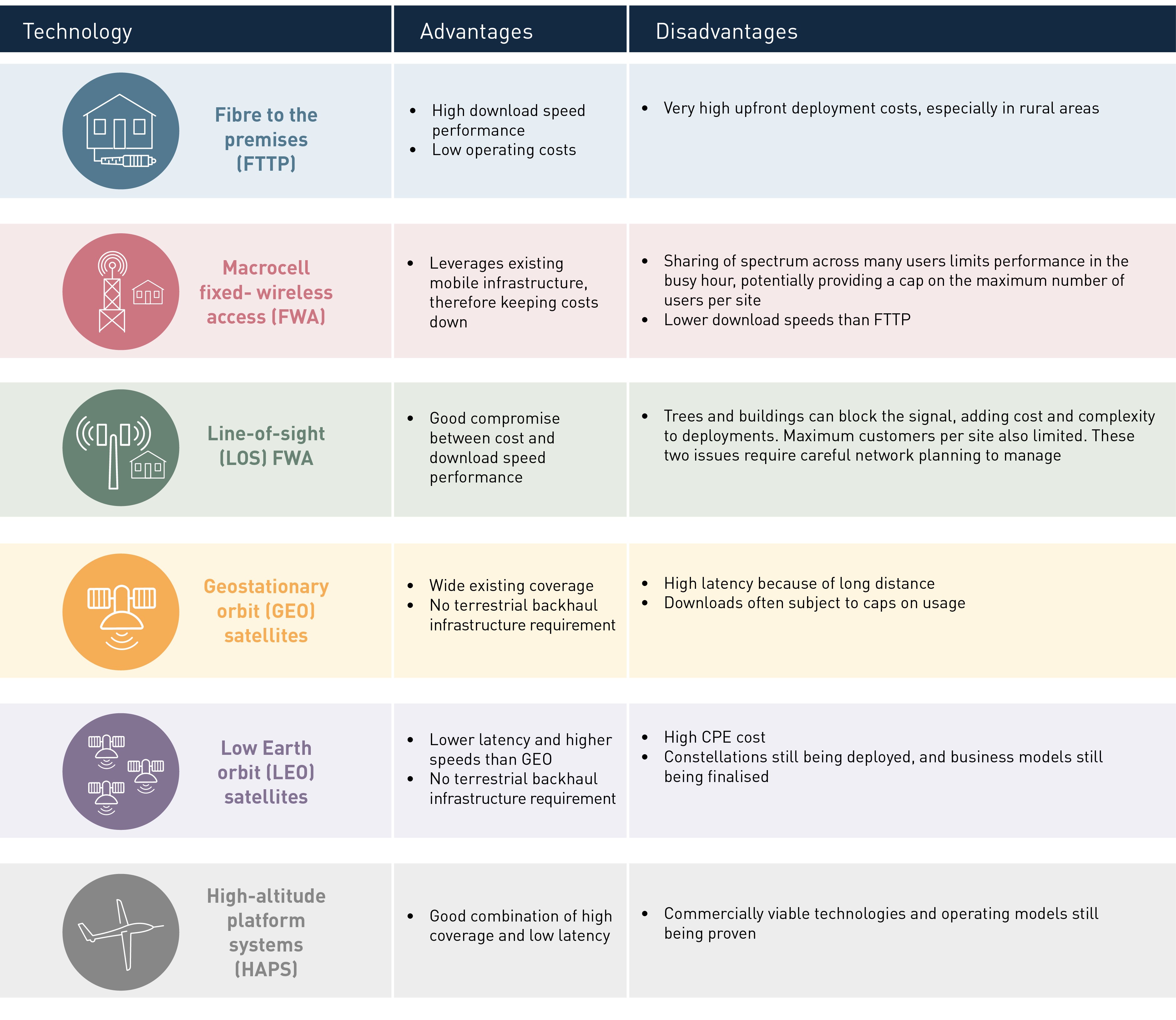Rural broadband: making the right technology choice
Listen to or download the associated podcast
Governments worldwide are seeking to bring broadband connectivity to underserved and hard-to-reach citizens in rural areas. This will bring significant opportunities for citizens, governments, operators and suppliers.
In a project for UK communications providers, we identified six different broadband technologies that can be used to connect very hard-to-reach premises with at least 30Mbit/s download performance.
All these technologies are continually being improved and will deliver much higher performance over the next few years (Figure 2). This article briefly describes each technology, and assesses their strengths and weaknesses.
Deploying broadband in rural areas is economically challenging. Typically, it is difficult or impossible for commercial operators to fully recover their investment from the revenue paid by the residents and/or businesses in sparsely populated areas. Therefore, rural broadband is often provided via government intervention; governments support investment when the normal commercial processes have not addressed citizens’ needs. As such, these interventions deliver critical services that are needed but are not fully justified by the normal commercial investment criteria.
Policy makers have many factors to consider, including their overall societal goals, and constraints related to the amount of investment available, the role of established network operators and their target date for getting complete coverage. An important choice in any rural broadband deployment is which technologies will best achieve their goals while accounting for these factors.
The right technologies are those that deliver the needed level of performance to the most premises at the lowest cost. The right technology choice varies by country because of different levels of existing broadband coverage, differences in deployment costs, different settlement patterns in rural areas and different levels of government funding. In many cases, multiple technologies will be needed to provide the optimal solution.
Six alternative rural broadband technologies
Figure 1: Comparison of six technologies for rural broadband
Figure 2: Typical achievable download speeds now and in the future for different fixed broadband technologies

Fibre to the premises (FTTP)
FTTP involves laying a fibre-optic connection between the end-user premises and the nearest fibre-enabled backhaul point. Using passive optical network (PON) architecture, optical splitters enable a single optical fibre from the backhaul point to serve multiple subscribers (typically 32 or 64 on each fibre). This reduces the total amount of fibre-optic cable required in the network. Performance is limited only by the termination equipment. FTTP currently offers up to around 1Gbit/s download speeds, although 10Gbit/s and even higher speeds are planned. Compared to wireless technologies, FTTP is much less affected by whether other users are also trying to access high speeds at the same time.
FTTP is the preferred fixed broadband technology in most urban settings. Most fixed broadband providers are now pushing toward full-FTTP deployments in urban and suburban situations. It offers very high performance, very low latency and has low ongoing operating costs.
However, FTTP has very high upfront deployment costs compared to other technologies. In urban and suburban environments, this cost is spread across many premises passed, due to the short distances between the premises. The cost per premises passed is significantly higher in rural areas where premises are more sparsely located with long distances between each, making FTTP economically very challenging to deploy in these areas.
Macrocell FWA
Macrocell FWA uses the existing mobile network infrastructure; connectivity is provided wirelessly between the cell tower and a 4G- or 5G-enabled router at the end-user premises. Coverage and download speed performance depend mainly upon the spectrum bands used. All premises share the available bandwidth of the site (or sector on a multi-sectored site).
Macrocell FWA is attractive because it leverages mobile network infrastructure, which already exists to some degree in most areas. In rural areas, the low density of mobile users means there is likely to be capacity for FWA users in the spectrum that is currently held by mobile network operators.
Macrocell FWA uses a shared medium with limited total capacity (spectrum) for the end-user connection, and therefore at busy times, the download speed for each user can be limited by how many other premises are also using the service at the same time. Where infrastructure does not exist, extending the macrocell network simply to add FWA is rarely economically viable.
LOS FWA
LOS FWA technology uses short-range high-frequency wireless connections, over unlicensed or lightly licensed spectrum (for example, 5.8GHz, 60GHz) to provide connectivity to the end-user premises. Technology standards include WiGig and other vendor-proprietary solutions. LOS FWA local access points are normally connected by fibre backhaul.
LOS FWA is similar to a compromise between FTTP and macrocell FWA. It provides better performance than macrocell FWA (100Mbit/s), and because part of the connection is provided wirelessly, is generally lower cost than an FTTP connection.
Similar to macrocell FWA, all premises with LOS FWA share the available bandwidth of the spectrum deployed at the local access point. Furthermore, as the name suggests, LOS FWA requires line of sight, which can add complexity and cost to deployment; buildings and trees block the signal, and rain can degrade performance. Each customer premises receiver equipment must be aligned with the local access point. The design of the LOS FWA network is critical to avoid objects that can block the signal, and to ensure that the capacity is not shared by too many premises at any time. In very low-density areas, a local access point may serve very few customer premises, driving up the cost per premises served.
GEO satellites
GEO satellites hold a fixed position in the sky and are large (approximately 5 tonnes) with a long lifespan (approximately 15 years). GEO broadband solutions in many cases can leverage communications satellites that have already been launched. Connectivity is provided to a fixed receiver dish (known as a very-small-aperture terminal (VSAT)), which is mounted on the outside of the user premises and connected to an internal modem via coaxial cable.
GEO solutions are attractive because they cover nearly any location without the need for additional terrestrial backhaul equipment.
However, one of the main limitations of GEO satellites are their location; 36 000 km above the Earth’s surface. This causes high latency in the broadband service, which can affect customer experience on some applications, compared to other broadband technologies. Capacity on each satellite is also shared by many users and use cases. This constraint is typically managed by placing caps on customers’ data consumption or download speed.
LEO satellites
LEO satellites move position relative to the Earth’s surface and are smaller than GEO satellites (approximately 50–800kg) with a shorter lifespan (approximately 5 years). Providers include OneWeb and Starlink, both of which plan to provide worldwide coverage within the next few years.
Compared with GEO, LEO provides better throughput and lower latency. LEO providers claim they will provide 200Mbit/s or better download performance.
Because the satellites are moving, the customer receiver equipment needs to be more sophisticated than for GEO. There are two main technology options for the consumer antenna:
- A mechanical system (including a parabolic dish, a radome, motors, etc.), which physically moves to track the passing satellites.
- Electronically scanned array (ESA) antennas that can track moving satellites without physically moving. This complexity means that the receivers are costly to provide, and a significant charge can be passed onto end users (although costs are coming down).
Compared with terrestrial networks, LEO still also has some limitations in latency (but this is more of a problem GEO satellites).
HAPS
HAPS involves an airborne vehicle providing connectivity from high in the Earth’s atmosphere. This can be achieved from an unmanned aerial vehicle (UAV), a balloon or an airship. The altitude of the platform can vary from a few hundred metres to several kilometres. HAPS and its payload need to stay in approximately the same location relative to the ground to provide consistent coverage. HAPS solutions have had some well-publicised trials, but the technology and business models are yet to reach a point where commercially viable deployments can take place.
Conclusions
Each technology has its advantages and disadvantages. All have serious cost implications in rural areas, which will require government subsidies in some cases.
The right technologies are those that deliver the needed level of performance to the most premises at the lowest cost. The right technology choice varies by country because of different levels of existing broadband coverage, differences in deployment costs and different levels of government funding. In many cases, multiple technologies will be needed to provide the optimal solution.
Article (PDF)
DownloadAuthor

Andrew Daly
Principal
Oliver Loveless
Principal, expert in broadband interventionRelated items
See moreArticle
Rural coverage initiatives: stakeholders can learn from the successes and failures of past efforts
Article
Opportunities for network operators emerge as subsidy schemes enable rural broadband expansion
Article
Rural broadband presents new opportunities and unique challenges for the telecoms industry

